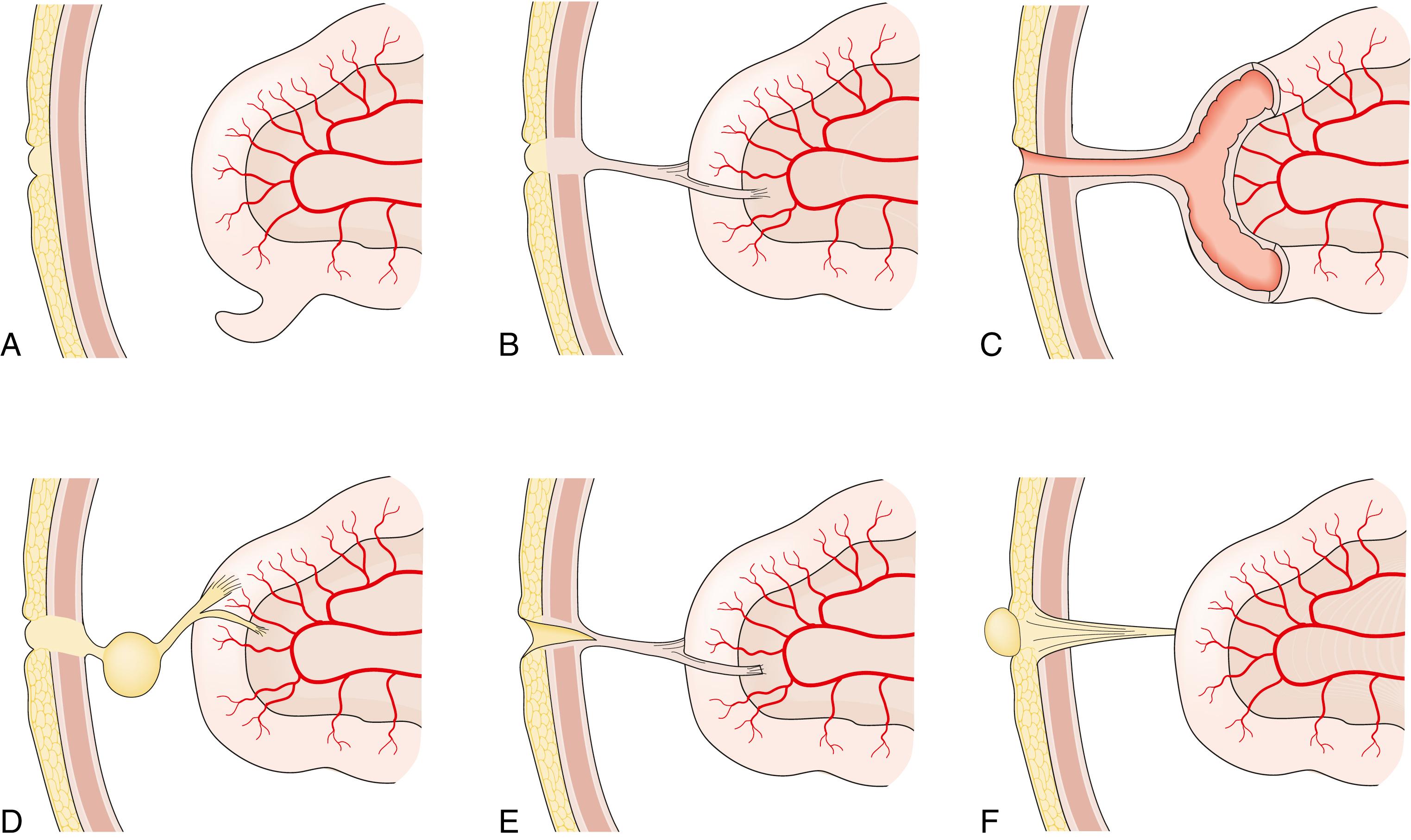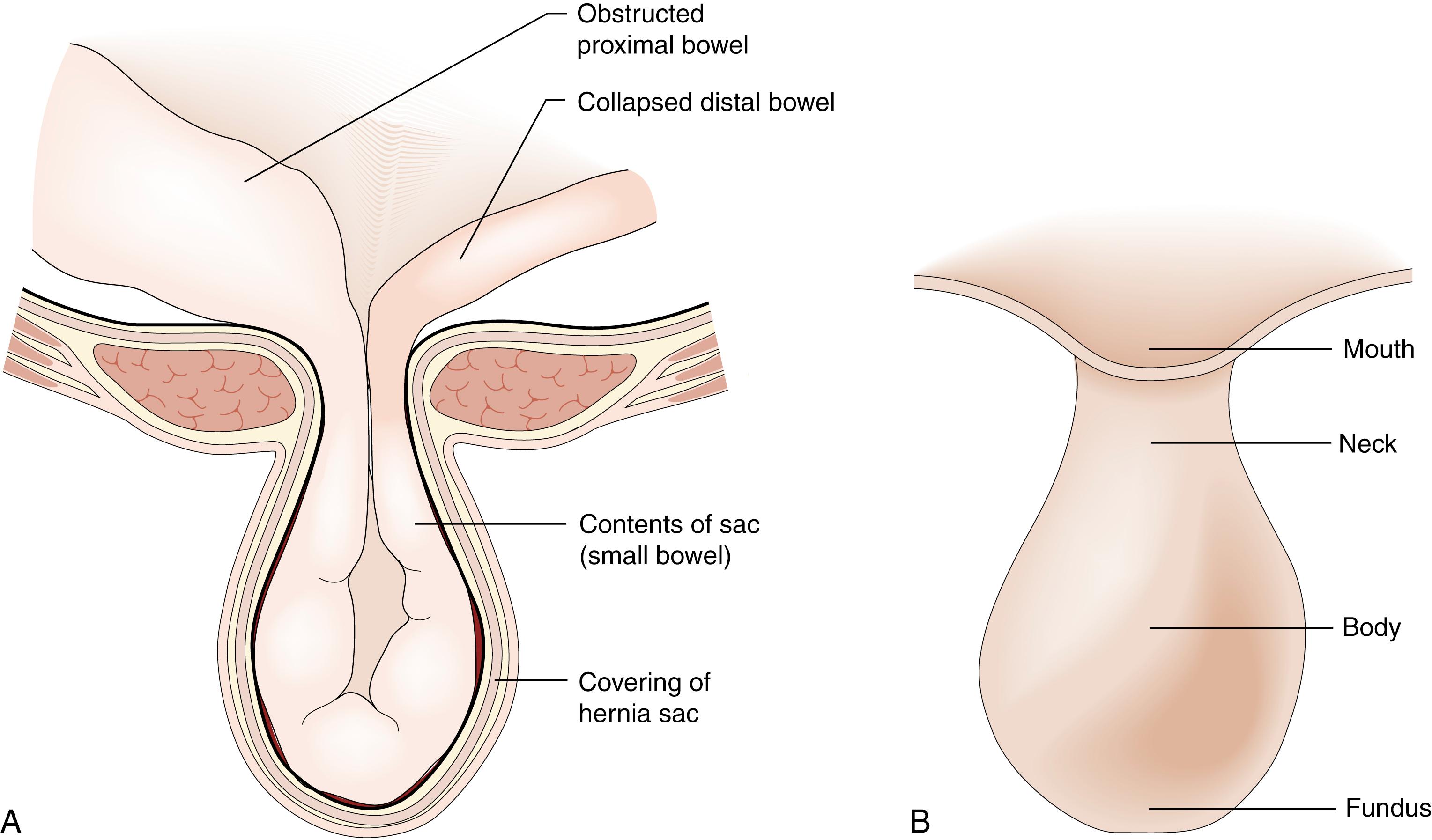Physical Address
304 North Cardinal St.
Dorchester Center, MA 02124
The umbilicus is a scar on the abdomen that all placental mammals have that can be flat, protruding or hollowed. Under the skin there is a dense fibrous ring that is easily palpable during examination. The skin around the umbilicus is innervated by the 10th thoracic spinal nerve. The linea alba is usually well defined above the umbilicus. Around the umbilicus there are portocaval venous anastomoses. In patients with portal hypertension, these can become visible, which is called the caput medusae sign.
Disorders of the umbilicus are either congenital or acquired, infectious or neoplastic.
Persistent vitello-intestinal duct is a very rare abnormality presenting as an intermittent discharge of enteric contents from the umbilicus. In intrauterine life, the vitello-intestinal duct runs from the apex of the midgut loop to the yolk sac. It normally disappears long before birth, but part of it may persist as a Meckel’s diverticulum on the antimesenteric border of the ileum. Rarer abnormalities include persistence of a band attaching the umbilicus to a Meckel’s diverticulum or a loop of ileum; a patent communication (fistula) between the ileum and umbilicus; an encysted portion of the duct that does not connect with the ileum (enterocystoma); an umbilical sinus; or a persistent umbilical portion of the duct, which forms a polypoidal raspberry-like tumour of the umbilicus (enteroteratoma) ( Fig. 12.1 ). Symptomatic remnants may have to be excised, although a broad-based Meckel’s diverticulum is usually left alone if found incidentally at laparotomy. Narrow-based Meckel’s diverticulum can mimic acute appendicitis, and its inflammation is one of the potential causes of an acute abdomen. Persisting bands can cause intestinal obstruction.

The urachus is a fibrous remnant of a canal draining the foetal urinary bladder. It runs from the apex of the bladder to the umbilicus. It is normally destroyed at birth but may give rise to cysts, a urinary fistula or a discharging umbilical sinus if parts of it remain patent. Symptomatic remnants require excision.
Omphalitis is an inflammation of the umbilicus that can lead to umbilical sepsis and is caused by bacteria travelling through the umbilical vessels in neonates and may give rise to portal thrombophlebitis, liver abscess formation, jaundice and portal vein thrombosis, which may result in portal hypertension. Tetanus can follow the application of cow dung to the umbilicus, as was once practised in some underdeveloped societies.
In adults, sepsis can result from retention of inspissated sebum within the folds of the umbilicus and from infection of a pilonidal sinus of the umbilicus. Infection is usually a mixture of staphylococcal and streptococcal, characterised by erythema, tenderness and swelling. Treatment involves drainage of any pus and the prescription of systemic antibiotics. Rarely, excision of the umbilicus is required.
Granuloma is a relatively common pseudotumor presenting as a lump in the umbilicus. It can be an inflammatory swelling around suture material following previous surgery but also a chronic infection of the umbilical scar.
The umbilicus may rarely be involved by primary neoplasms (e.g., squamous carcinoma or melanoma), or by secondary tumour that has tracked along the ligamentum teres from the liver or lymph nodes in the porta hepatis. Cutaneous metastases of the umbilicus are called Sister Mary Joseph nodules in honour of Sister Mary Joseph, the first to note the link between umbilical nodules and intraabdominal malignancy. They are usually associated with a poor prognosis. Neoplasia is an occasional unexpected finding in an umbilicus that has been excised because of persistent discharge.
Spontaneous or traumatic rupture of a branch of the inferior epigastric artery can result in a painful swelling within the rectus sheath in association with rigidity of the affected side of the abdominal wall. This condition is rare but may represent an unusual presentation of acute abdominal pain in the elderly patient, especially if they are on anticoagulation therapy. A history of excessive physical exertion may precede the onset of symptoms. Ultrasonography can be used to confirm the diagnosis. Spontaneous resolution is typical, but evacuation of clot may be rarely indicated for symptom control.
This rare tumour is thought to arise from fibrous intramuscular septa in the lower rectus abdominis muscle. It is more common in women of child-bearing age and can be associated with intestinal polyposis in Gardner’s syndrome. It does not change in size when the abdominal muscles are contracted. The lesion must be excised widely, as it is prone to recur and can become malignant (fibrosarcoma). The resultant defect often needs to be reconstructed with a prosthetic mesh after excision of the tumour.
A hernia is an abnormal protrusion of a cavity’s contents through a weakness in the wall of the cavity, taking the linings of the cavity with it, although these may be markedly attenuated ( Fig. 12.2 ). Hernias of the abdominal wall are common. Multiple factors contribute to the development of hernias, which can be considered design faults, either anatomic or through inherited collagen disorders; however, these two factors work together in the majority of patients. Hernias may exploit natural openings such as the inguinal and femoral canals, umbilicus, obturator canal or oesophageal hiatus, or protrude through areas weakened by stretching (e.g., epigastric hernia) or surgical incision. In addition to these ‘weak’ anatomic areas, the collagen make-up of the tissues, especially the type I to III collagen ratio, is also important. Type I imparts strength to the tendon or fascia, whereas type III provides elastic recoil to the tissue. The type I/III collagen ratio varies between individuals but is constant in all the fascia of a particular individual. Hernias can be considered a disease of collagen metabolism.

The hernia is immediately invested by a peritoneal sac drawn from the lining of the abdominal wall ( Fig. 12.2 ). The sac is covered by those tissues stretched in front of it as the hernia enlarges (i.e., the coverings). The neck of the sac is the constriction formed by the orifice in the abdominal wall through which the hernia passes. A hernia may contain any intraabdominal structure but most commonly contains omentum and/or small bowel. A hernia may involve only part of the circumference of the bowel (Richter hernia), a Meckel’s diverticulum (Littré hernia) or an incarcerated appendix (Amyand hernia). A sliding inguinal hernia is defined as one in which a viscus forms a portion of the wall of the hernia sac. Most commonly, the viscus involved is the caecum, sigmoid colon or urinary bladder. In the early stages of a hernia, sometimes the hernial contents are preperitoneal fat only, such as a lipoma of the cord, which can mimic an inguinal hernia.
Become a Clinical Tree membership for Full access and enjoy Unlimited articles
If you are a member. Log in here